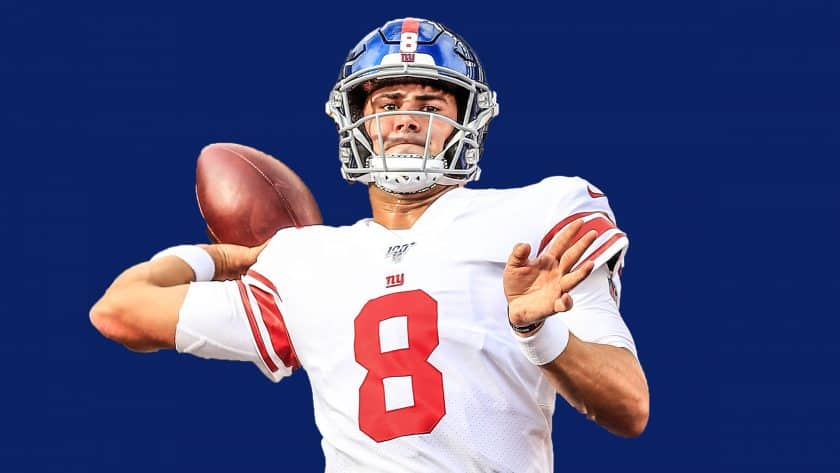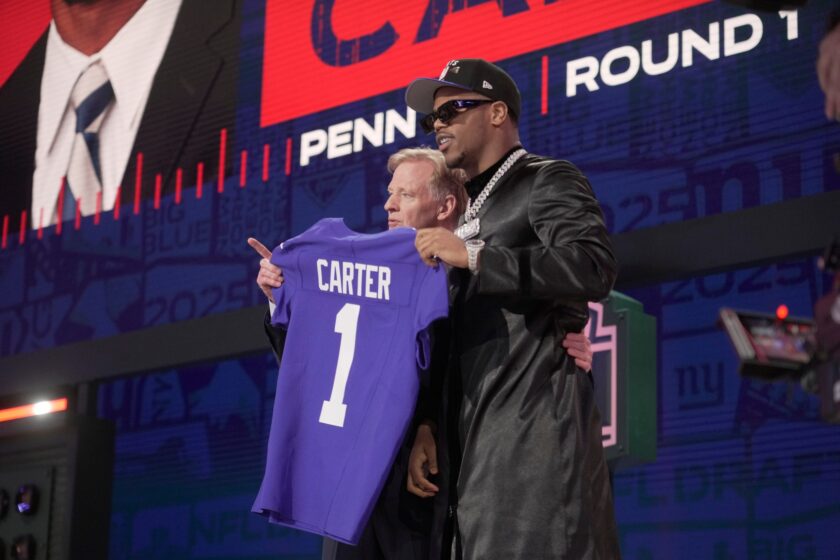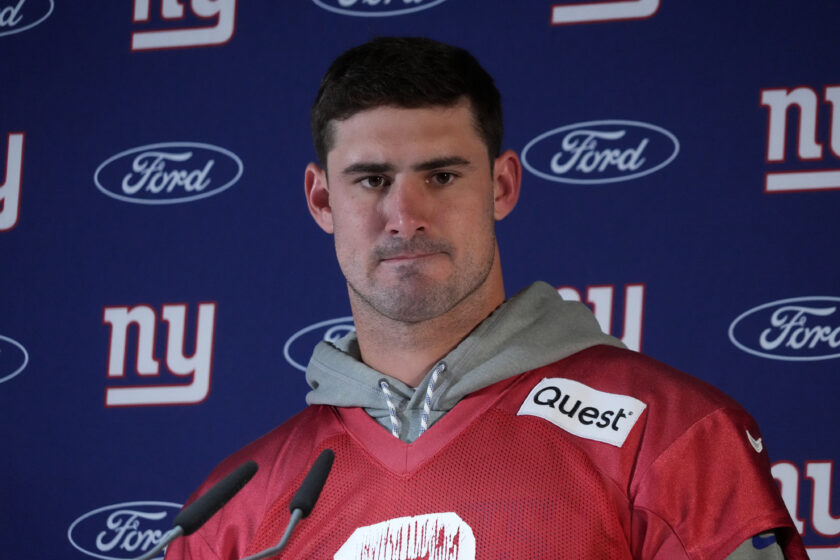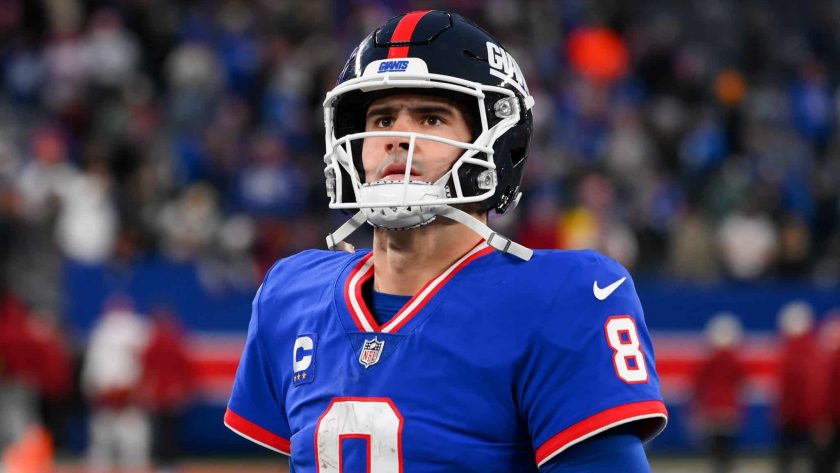New York Giants QB Daniel Jones just doesn’t yet have the support

The support around New York Giants rookie quarterback Daniel Jones isn’t fully present and it’s contributing to his early struggles.
[sc name=”Ryan Honey Banner”]After suffering a defeat at the hands of the Arizona Cardinals on Sunday, the New York Giants have dropped to 2-5 on the year. More specifically, rookie quarterback Daniel Jones has fallen to 2-3 as a starter, and his struggles haven’t gone unnoticed.
The Duke product, who Big Blue selected with the No. 6 pick in April’s draft, hasn’t exactly lit up the stat sheet thus far. Through his five starts, Jones has completed 60.92% of his throws for 1,127 yards, six touchdowns and seven interceptions. He’s additionally lost four fumbles.
Thus, Jones is averaging 225.4 yards, 1.2 touchdowns and 1.4 interceptions per start. He’s also averaging 0.8 fumbles lost-per-start, which puts him at 2.2 turnovers-per-start. If it weren’t for his initial start in which he defeated Tampa Bay (23-26, 336 yards, two touchdowns, and two lost fumbles), Jones would be averaging a 60.18% completion percentage 197.75 yards, 1.0 touchdown, 1.75 interceptions, and 0.5 fumbles lost-per-start. This would put him at 2.25 turnovers-per-start.
The numbers speak for itself. Jones is struggling overall for the Giants. However, fans shouldn’t be pointing the finger at him just yet. When you’re starting a 22-year-old rookie at arguably the toughest position in sports, you need to consider the support around him.
Right now, that help for Jones isn’t fully existent and there are numerous contributing aspects.
[sc name=”Giants Title” text=”The Injury-Related Issues” ]When you look back at the injuries to Jones’s offensive weapons, it’s insane what the rookie has had to deal with. In each of his five starts, he’s had the top guy at either the running back, wide receiver or tight end positions either miss the game or exit early.
Against the Buccaneers in Week 3, Saquon Barkley left before halftime. Against the Redskins in Week 4 and then the Vikings in Week 5, the team was without Barkley. In the loss to the Patriots in Week 6, the Giants were without Barkley, Sterling Shepard and Evan Engram. Finally, in the recent loss to the Cardinals, the team was without Shepard.
The only game in which each of them at least started was the win against Tampa Bay.
The rookie quarterback needs consistent healthy support, just like any other first-year quarterback in this league does. The Giants haven’t provided that for Jones at all, and it’s contributed to the offensive mistakes.
[sc name=”Giants Title” text=”Poor Coaching and Play-Calling” ]Did you see the play-calling in the loss to Arizona? I want to know why exactly this offense would run a draw play on a third-and-18 if they were just going to go for it on fourth down anyway.
Head coach Pat Shurmur did say the play call was due to the Cardinals playing in a soft, two-deep safety set. However, why wouldn’t you try to throw it there to get maybe 5-6 more yards than you would from running it? Wouldn’t that make the succeeding fourth-down play more manageable?
Some of the decisions Shurmur has made are just baffling. Why haven’t they attempted to use a two-back set with Barkley and Wayne Gallman? We saw that Gallman can be a reliable talent out of the backfield with his two touchdowns against the Redskins in Week 4. Not to mention, one of those touchdowns was on the ground and one was through the air. Thus, Gallman has shown versatility.
Why isn’t Saquon getting used as much in the passing game as he was last year? I understand Jones has more of a tendency to not check it down on certain pass plays, such as Eli Manning did. However, getting the ball in Barkley’s hands is a “key to victory” no matter who this team is going up against.
This year, in games Barkley has finished (not counting the Tampa Bay game where he exited prior to halftime), Barkley is averaging 6.0 targets. Last year, the sensational back averaged 7.56 targets-per-game. This guy needs to be utilized to his maximum potential, such as what the Carolina Panthers do with Christian McCaffrey. That starts with getting him more involved in the passing game.
Lastly, the personnel usage by Shurmur has made this offense (thus, Jones) look bad as well. While up 17-3 on the Redskins late in the third quarter three weeks ago, the Giants were driving and found themselves at the doorstep. Who did they decide to give the ball to on the goal line? None other than undrafted rookie running back Jon Hilliman. Why? No one knows.
[sc name=”Giants Center”]You have a very talented tight end in Engram, a talented receiver in Shepard and even another running back (Gallman and Barkley were hurt at the time) in Elijhaa Penny who’s mainly a fullback. Thus, he’s suited for situations such as that. You have numerous other options, but Shurmur still decided that giving it to Hilliman was the best option in that situation.
Additionally, in the loss to Minnesota, the Giants forced a Dalvin Cook fumble near the goal line. Big Blue was down 13-7 with a little over two minutes to go. Needless to say, they could’ve driven down to get points before the half. With a first-and-10 at their own one-yard line (obviously a tough spot), who’s number does Shurmur call once again? That’s right … Hilliman’s number.
It’s personnel-usage decisions such as these that hurt the offensive momentum and end drives much earlier than they should.
[sc name=”Giants Title” text=”The Struggling Offensive Line” ]I’m really tired of hearing how this offensive line has “improved,” how the additions of guard Kevin Zeitler, tackle Mike Remmers and the return of center Jon Halapio were going to propel this offensive line to be better than it has in the past. It absolutely hasn’t improved as the five individuals showed in the loss to Arizona that they’re nowhere near the type of line they need to be.
Through Jones’ five starts, the front-five has averaged 3.6 sacks allowed-per-game and 25.2 sack yards allowed-per-game. Last year, with the less-mobile Manning at quarterback, the offensive line group averaged 2.94 sacks allowed-per-game and 22.38 sack yards allowed-per-game.
The tackles have gotten better, but still aren’t great. In 2018, Nate Solder and Chad Wheeler combined for 76 allowed pressures through seven games. Solder allowed 33 and Wheeler allowed 43. That’s an average of 10.86 pressures allowed-per-game from the tackles, which would be on-pace for 173.7 pressures allowed-per-16 games.
However, this year, Solder has allowed 26 pressures and right tackle Mike Remmers has allowed 24 through seven games, combining for 50. That’s an average of 7.14 pressures allowed-per-game, on pace for 114.29 pressures allowed-per-16 games.
Therefore, that part of the line has actually improved thus far. But, as football fans may know, five individuals are needed to put together a dominant offensive line. Not just two.
It takes a lot more than just what you see on the surface to show that this offensive line is an issue. Right now, it only seems like they’re better because they actually have a quarterback now who can be mobile and get outside of the pocket. Overall, this group isn’t improving at all and is proving to be one of the least-consistent lines in the league.
[sc name=”Twitter Follow Link” text=”Ryan” username=”@RyanHoneyESNY” ] [sc name=”Giants Link Next” link=”https://elitesportsny.com/2019/10/21/new-york-giants-trade-deadline-2019-3-players-to-place-on-market/” text=”Three Giants Who Could Be Placed On The Trade Market” ]





